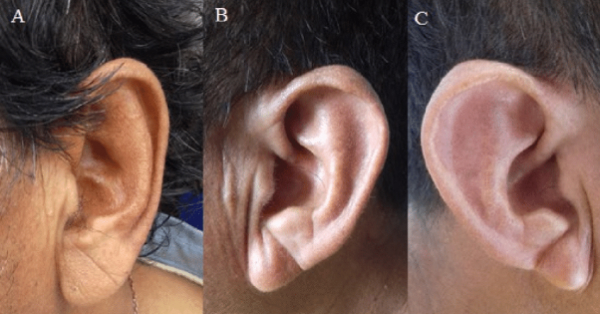
Last Updated On: December 26, 2024
Have you ever seen an earlobe crease in certain people that seems like a diagonal line? It is called the Frank’s sign and is in the form of a deep crease or wrinkle that extends to the earlobe. Several studies suggest that the crease indicates a greater risk for coronary artery diseases, which cause heart attacks. Over 40.5% of the US population will have some form of cardiovascular disease by 2030. This may occur when the heart muscle becomes damaged due to a lack of blood flow in the body. Read on to learn more about the connection between an earlobe crease and heart disease factors in detail.
An earlobe crease is a visible line or wrinkle that runs diagonally across the earlobe. It is commonly referred to as Frank’s sign.
Earlobe creases can appear in one or both ears and are more common in older individuals, possibly due to aging and reduced skin elasticity. However, in some cases, they have been associated with underlying health conditions, particularly coronary artery disease (CAD). The crease may indicate vascular changes or reduced blood flow, which could mirror similar changes in the heart’s blood vessels.
While the presence of an earlobe crease is not a definitive diagnostic marker, it may warrant further medical evaluation, especially in individuals with other risk factors for heart disease.

Earlobe Creases seen in different individuals
The connection between Frank’s sign and cardiovascular risks was established in 1973 by Sanders T. Frank in 1973 after experimenting on 20 patients with angina or chest pain. He observed a crease of 45° between the auricle and the tragus in all the patients and concluded that they had proven coronary artery blockages.
In a letter published in the New England Journal of Medicine, Dr. Frank described this possible link between an earlobe crease and heart disease.
The connection between an earlobe crease and heart disease has been a topic of debate. The Copenhagen City Heart Study, a comprehensive 35-year research project, found that earlobe creases, along with xanthelasma and crown top baldness, were independently associated with ischemic heart disease and myocardial infarction. This association held true even after adjusting for well-known cardiovascular risk factors.
In another study by Pasternac and Sami, 340 patients undergoing coronary arteriography for cardiac complaints were examined. Among these, 75.6% of those with coronary artery disease also displayed a diagonal earlobe crease. The study reported a sensitivity of 59.5%, a specificity of 81.9%, and a positive predictive value of 91.1% for the crease as one of the signs of coronary artery disease.
Although the exact reason for this link remains unclear, researchers suggest it may result from similar processes affecting both the earlobes and coronary arteries, such as age-related or microvascular disease that weakens elastic fibers.
The debate about whether the earlobe crease is a myth or a fact continues among researchers and medical professionals in the present context. Initially, the earlobe crease was thought to be linked to coronary artery disease simply because it often appeared alongside other risk factors like smoking, diabetes, obesity, and high blood pressure. Critics argued that the crease itself was not a direct indicator but rather a byproduct of these common cardiovascular risk factors.
However, studies began to challenge this view, showing that the earlobe crease was independently associated with coronary artery disease, even after accounting for other risk factors. The most compelling evidence comes from the largest study to date, involving nearly 11,000 Danish participants tracked over 35 years. At the start, none had known coronary artery disease.
The study revealed that individuals with a defined earlobe crease had a significantly higher risk of developing serious heart conditions, including heart attacks and ST-segment elevation myocardial infarctions. These findings were consistent even when well-known cardiovascular risk factors were excluded, strengthening the argument that the earlobe crease may be more than just a coincidence.
Earlobe creases are still considered to be a key predictor of heart disease in individuals. That is why it is necessary to get yourself checked for any signs or symptoms if you have a diagonal crease. You can even do a self-diagnosis by standing in front of a mirror with good lighting. The steps include:
Look at each earlobe in the mirror. Focus on the lower part of the lobe and check for a diagonal line or indentation that runs from the canal opening to the edge of the earlobe.
Check both earlobes, as the crease can appear on one side or both. The line should be distinct and separate from normal skin folds caused by aging or movement.
Ensure the crease is not a temporary skin fold from sleeping positions, pressure from glasses, or general skin sagging. A true earlobe crease is more permanent and visible regardless of posture or expression.
Read More: What is Cardiac Massage and Types of Cardiac Massage Techniques
An earlobe crease is not the only reason behind coronary artery diseases or heart attacks. Several other risk factors indicate the risks of heart disease in individuals. These include:
There is an increased risk of damaged and narrowed arteries when you grow older. This also implies having a weakened or thickened heart muscle. Men are at greater risk of heart disease than women, who often witness it after menopause.
A family history of heart disease may also increase a person’s risk of getting coronary artery disease. This applies especially if either of their parents developed the same condition at an early age. That means before age 55 for a male relative, like your brother or father, and 65 for a female relative, like your mother or sister.
You must consider quitting if you like to smoke frequently. Several substances are present in tobacco that damage your arteries. Heart attacks are more common in individuals who smoke than in those who don’t smoke. You may also consult a healthcare professional if you need help quitting this addiction.
Diets high in sugar, fat, salt, and cholesterol have been linked to heart diseases. The consumption of these foods automatically leads to high blood pressure. A few people may also witness an increase in their cholesterol levels and obesity.
If you do not control high blood pressure, it can cause your arteries to become hard and thick. These changes may affect blood flow to your heart and the body. It also increases the likelihood of strokes, heart attacks, and other life-threatening heart conditions.
If you already have high cholesterol, it increases the risk of atherosclerosis, a condition that occurs when plaque builds up in the walls of your arteries. Atherosclerosis has always been linked to conditions like heart attack and stroke. Diabetes, obesity, and high blood pressure also increase the risk of heart disease.
Excess weight is known to worsen other heart disease risk factors in individuals. Being inactive is related to several forms of heart disease and some of its risk factors. This specifically applies to those who do not indulge in any kind of physical activity.
Emotional stress may damage your arteries and make other risk factors associated with heart disease worse. Chronic stress also increases the risk of blood pressure and inflammation, both of which strain the heart. Unmanaged stress may contribute to unhealthy behaviors like overeating, smoking, or lack of exercise. This also increases the risk of heart disease in individuals.
Unhealthy teeth and gums make it easier for bacteria to get into your bloodstream and travel to the heart. This can cause endocarditis, an inflammation of the inner lining of the heart’s chambers and valves. Make sure to brush and floss your teeth on time and get regular dental checkups.
You must speak to a healthcare professional if you notice an earlobe crease. Sometimes, you may already be experiencing other symptoms of heart disease, like chest pain or discomfort, indigestion, heartburn, nausea, or shortness of breath. If these symptoms are present, you may be suffering from underlying health conditions. Consult your doctor immediately if you witness these signs or seek treatment if you have severe pain or discomfort.
People may not be aware of heart disease or similar conditions until they experience symptoms. However, heart attack symptoms may vary for every individual. Anyone experiencing worsening symptoms or anything outside the ordinary must seek medical help immediately.
If you are a healthcare professional, you must understand the link between earlobe crease and heart diseases. This will help you diagnose and treat individuals immediately who are at risk of getting heart attacks. Consider getting a CPR certification to learn more about other symptoms and risk factors associated with heart disease. This will help you provide the most efficient treatment options for patients with heart conditions. Make sure to enroll in a recognized organization to ensure you have a credible certification to practice as a healthcare provider.
Read More: